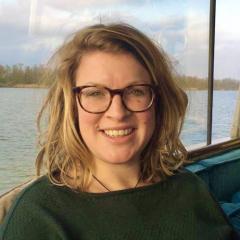Listening & reading materials
Practice vocabulary in context with real materials.
Vocabulary (16) Share Copied!
Exercises Share Copied!
These exercises can be done together during conversation lessons or as homework.
Exercise 1: Conversation exercise
Instruction:
- Noem de lichaamsdelen. (Name the bodyparts.)
- Beschrijf waar het pijn doet. (Describe where it hurts.)
Teaching guidelines +/- 10 minutes
Exercise 2: Dialogue Cards
Instruction: Select a situation and practice the conversation with your teacher or fellow students.
Exercise 3: Translate and use in a sentence
Instruction: Pick a word, translated and use the word in a sentence or dialogue.
1
Het been
The leg
2
Het oor
The ear
3
De vinger
The finger
4
De rug
The back
5
De hand
The hand
Exercise 4: Reorder sentences
Instruction: Make correct sentences and translate.
Exercise 5: Match a word
Instruction: Match the translations
Exercise 6: Cluster the words
Instruction: Sleep de lichaamsdelen naar de juiste categorie: 'Gezicht' of 'Lichaam' om ze beter te leren kennen.
Gezicht
Lichaam
Exercise 7: Veel gebruikte onregelmatige werkwoorden
Instruction: Fill in the correct word.
Grammar: Frequently used irregular verbs
Show translation Show answersgaat, zullen, heeft, is, ga, ben, heb
Grammar Share Copied!
It's not the most exciting thing, we admit, but it’s absolutely essential (and we promise it'll pay off)!
Verb conjugation tables for this lesson Share Copied!
Lopen to walk Share Copied!
Onvoltooid tegenwoordige tijd (OTT)
| Dutch | English |
|---|---|
| (ik) loop | I walk |
| (jij) loopt/loop | you walk/walk |
| (hij/zij/het) loopt | he/she/it walks |
| (wij) lopen | we walk |
| (jullie) lopen | you walk |
| (zij) lopen | they walk |
Zitten to sit Share Copied!
Onvoltooid tegenwoordige tijd (OTT)
| Dutch | English |
|---|---|
| (ik) zit | I sit |
| (jij) zit/zit je | you sit/you are sitting |
| (hij/zij/het) zit | he/she/it sits |
| (wij) zitten | we sit |
| (jullie) zitten | you sit |
| (zij) zitten | they sit |
Don't see progress when learning on your own? Study this material with a certified teacher!
Do you want to practice Dutch today? That is possible! Just contact one of our teachers today.


























